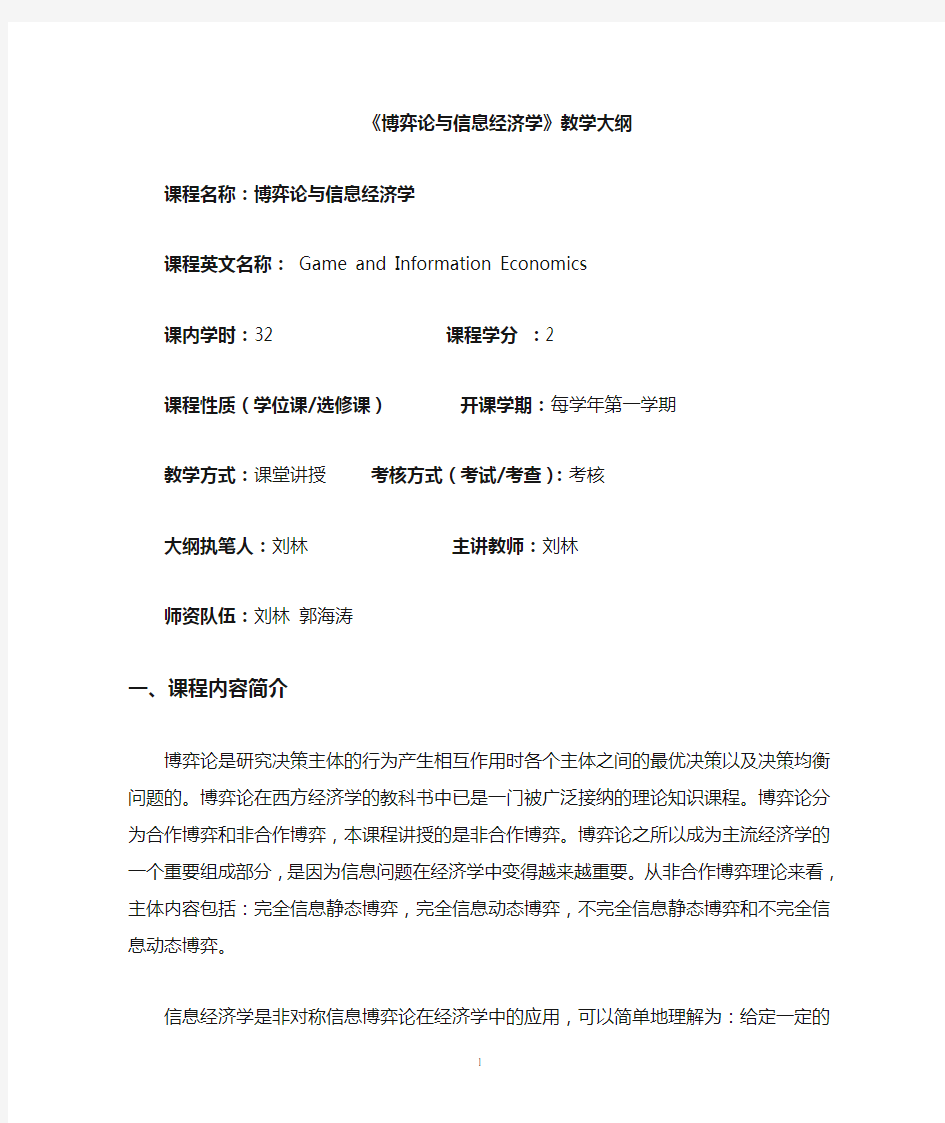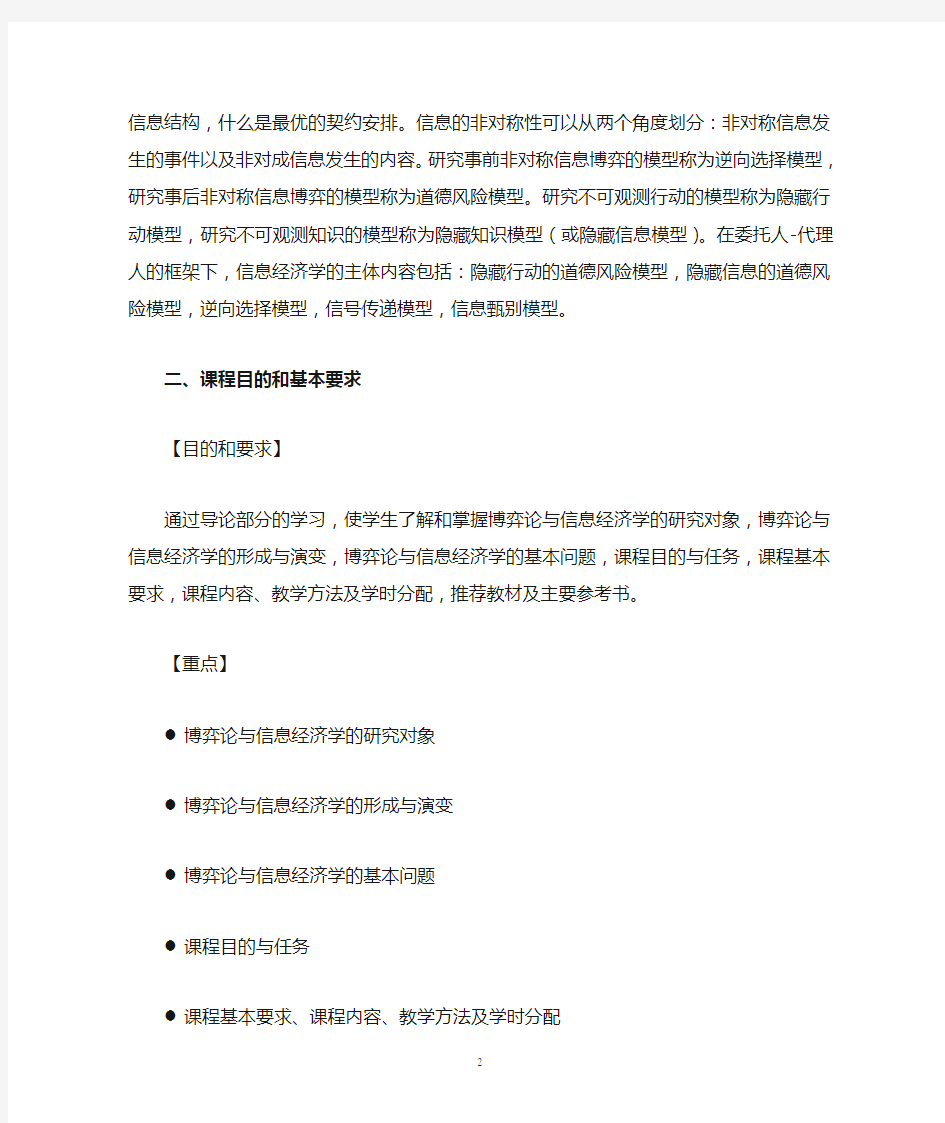博弈论与信息经济学-1pdfnet


《博弈论与信息经济学》教学大纲
课程名称:博弈论与信息经济学
课程英文名称: Game and Information Economics
课内学时:32 课程学分:2
课程性质(学位课/选修课)开课学期:每学年第一学期
教学方式:课堂讲授考核方式(考试/考查):考核
大纲执笔人:刘林主讲教师:刘林
师资队伍:刘林郭海涛
一、课程内容简介
博弈论是研究决策主体的行为产生相互作用时各个主体之间的最优决策以及决策均衡问题的。博弈论在西方经济学的教科书中已是一门被广泛接纳的理论知识课程。博弈论分为合作博弈和非合作博弈,本课程讲授的是非合作博弈。博弈论之所以成为主流经济学的一个重要组成部分,是因为信息问题在经济学中变得越来越重要。从非合作博弈理论来看,主体内容包括:完全信息静态博弈,完全信息动态博弈,不完全信息静态博弈和不完全信息动态博弈。
信息经济学是非对称信息博弈论在经济学中的应用,可以简单地理解为:给定一定的信息结构,什么是最优的契约安排。信息的非对称性可以从两个角度划分:非对称信息发生的事件以及非对成信息发生的内容。研究事前非对称信息博弈的模型称为逆向选择模型,研究事后非对称信息博弈的模型称为道德风险模型。研究不可观测行动的模型称为隐藏行动模型,研究不可观测知识的模型称为隐藏知识模型(或隐藏信息模型)。在委托人-代理人的框架下,信息经济学的主体内容包括:隐藏行动的道德风险模型,隐藏信息的道德风险模型,逆向选择模型,信号传递模型,信息甄别模型。
二、课程目的和基本要求
【目的和要求】
通过导论部分的学习,使学生了解和掌握博弈论与信息经济学的研究对象,博弈论与信息经济学的形成与演变,博弈论与信息经济学的基本问题,课程目的与任务,课程基本要求,课程内容、教学方法及学时分配,推荐教材及主要参考书。
【重点】
●博弈论与信息经济学的研究对象
●博弈论与信息经济学的形成与演变
●博弈论与信息经济学的基本问题
●课程目的与任务
●课程基本要求、课程内容、教学方法及学时分配
【难点】
●博弈论与信息经济学的基本问题
三、课程主要内容
课程目的与任务
本课程是经济学及相关专业高年级学生的一门理论知识基础课,其任务是通过教学和讨论以及决策行为的分析与演示,使学生比较系统地掌握博弈论与信息经济学的基本概念、基本理论、基本分析方法,并在此基础上培养一定的博弈决策技能,为后续学习及研究工作打下良好的理论知识基础。
课程基本要求
1、要求学生比较系统地掌握博弈论与信息经济学的主要内容和研究方法,特别是要准确掌握博弈论的一些重要的核心概念。
2、要求学生能够理论联系实际,运用博弈论与信息经济学的基本概念、基本理论、基本分析方法,对经济学及相关专业的决策行为进行博弈分析。
3、要求学生能够运用数学方法掌握博弈论与信息经济学初级课程中一定数量的经典理论模型。
4、要求学生能够初步运用博弈论与信息经济学的规范方法分析、解决一定程度的理论与现实决策行为问题。
导论:博弈论与信息经济学(3学时)
教学方法:讲授+讨论
完全信息静态博弈 (3学时)
博弈论的基本概念及表述;纳什均衡(占优战略均衡,重复剔出的占优均衡,纳什均衡);纳什均衡应用举例(Cournot Model,Hotelling Model,公共地的悲剧,公共物品的私人自愿供给);混合战略纳什均衡;纳什均衡的存在性和多重性讨论。
教学方法:讲授+讨论。讨论主题,讨论形式。
完全信息动态博弈 (3学时)
博弈的拓展式表述;拓展式表述博弈的纳什均衡;子博弈精炼纳什均衡(基本概念,逆向归纳法求解,承诺行动与子博弈精炼纳什均衡,逆向归纳法求解和子博弈精炼纳什均衡存在的问题);子博弈精炼纳什均衡应用举例(Stackelberg Model,宏观经济政策的动态一致性,工会与雇主之间的博弈,轮流出价的讨价还价模型);重复博弈和无名氏定理(有限次重复博弈举例,无限次重复博弈和无名氏定理,参与人不固定时的重复博弈,不确定环境下的重复博弈)。
教学方法:讲授+讨论。讨论主题,讨论形式。
不完全信息静态博弈 (3学时)
不完全信息博弈和贝叶斯纳什均衡(不完全信息博弈,海萨尼转换,不完全信息静态的战略式表述和贝叶斯纳什均衡);贝叶斯均衡的应用举例(不完全信息条件下的Cournot Model,不完全信息条件下的公共产品的提供,一级密封价格拍卖,双方叫价拍卖);贝叶斯博弈与混合战略均衡;机制设计理论与显示原理,不完全信息与自愿配置效率)。
教学方法:讲授+讨论。讨论主题,讨论形式。
不完全信息动态博弈(3学时)
精炼贝叶斯纳什均衡(基本思想,贝叶斯法则,精炼贝叶斯均衡,不完全信息博弈的精炼贝叶斯均衡);信号传递博弈及其应用举例(Milgrom-Robert Model,用负债比例显示企业质量);精炼贝叶斯均衡的再精炼及其他均衡概念(劣剔出战略,直观标准,Kreps-Wilson序贯均衡,Selten的颤抖手均衡);不完全信息重
复博弈与声誉(KMRW声誉模型,声誉模型的一个应用:政府的货币政策);博弈论均衡概念总结。
教学方法:讲授+讨论。讨论主题,讨论形式。
委托代理理论(第一部分)(3学时)
信息经济学引论;委托代理理论的基本分析框架;对称信息情况下的最优合同(最优风险分担合同,最优努力水平问题);信息不对称情况下的最优激励合同;委托代理模型举例。
教学方法:讲授+讨论。讨论主题,讨论形式。
委托代理理论(第二部分)(3学时)
多阶段动态模型(代理人市场-声誉模型,“鞭打快牛”模型);委托人的道德风险与锦标制度;多项任务委托-代理模型与资产所有权;效率工资与监督力度(效率工资下的监督问题,激励工资下的监督问题);团队工作与委托人的作用;最优的委托权安排。
教学方法:讲授+讨论。讨论主题,讨论形式。
逆向选择与信号传递(3学时)
旧车市场(偏好相同的两类卖主,偏好相同连续分布的卖主,买者对车的评价超过卖者,卖者的评价不同);保险市场;信贷市场;Spence劳动力市场模型(教育不影响劳动生产率情况下,教育提高劳动生产率情况下,雇主甄别教育信息模型)。
教学方法:讲授+讨论。讨论主题,讨论形式。
博弈论与信息经济学最新研究论文选读(5学时)
教学方法:学生研读与教师指导相结合
课程总结(3学时)
教学方法:讲授
四、推荐教材及主要参考书
1、博弈论与信息经济学,张维迎,上海三联书店、上海人民出版社,1996年。
2、现代产业组织,单·卡尔顿、杰·佩罗夫,上海三联书店、上海人民出版社,1998年。
3、D.Fudenberg and J.Tirole,Game Theory ,MIT Press,1991.
4、R.Gibbons, A Primer in Game Theory, Harvester Wheatsheaf Press,1990.
5、J.Friedman, Game Theory with Applications to Economics, Oxford University Press, 1990.
推荐阅读论文
Reading List Ⅱ
1.Grossman, S. and O. Hart, 1986, The Costs and Benefits of Ownership: A Theory of Vertical
and Lateral Integration, Journal of Political Economy, 94: 691-719
https://www.360docs.net/doc/8417149492.html,ffont, J. and J. Tirole, 1986, Using cost observation to regulate firms, Journal of Political
Economy 94, 614-641.
3.Morris, Stephen, 2001, Political Correctness, Journal of Political Economy, 109:231-265
4.Rayo, Luis, Relational Team Incentives and Ownership, 2002,
https://www.360docs.net/doc/8417149492.html,/seminars/microt/mt02/rayo-020911.pdf
5.Horner, Johannes, 2002, Reputation and Competition, American Economic Review, 92:
644-663
6.Ely, Jeffrey and Juuso Valimaki, 2003, Bad Repuation, Quarterly Journal of Economics, 118:
785-814.
7.Jonathan Levin, 2003, Relational Incentive Contracts, American Economic Review, 835-857;
or https://www.360docs.net/doc/8417149492.html,/~jdlevin/research.htm
Reading ListⅠ
0.General References
1. * Mas-Colell, A., M. Whinston and J. Green, 1995, Microeconomic Theory,
Oxford University Press.
2. Fudenberg, D. and J. Tirole, 1990, Game Theory, MIT Press
I. Mechanism Design
I 1. Basic Theory
3. * Mas-Colell, Whinston and Green, Chapter 23.
4. Myerson, R. and M. Satterthwaite, 1983, Efficient Mechanisms for Bilateral Trade, Journal
of Economic Theory, 29:265-281.
I 2. Applications
5. Cai, H., A. Bernardo and J. Luo, 2001, Capital Budgeting and Compensation with
Asymmetric Information and Moral Hazard, Journal of Financial Economics, 61:311-344. 6. Harris, M. and A. Raviv, 1996, The Capital Budgeting Process: Incentives and
Information, Journal of Finance, 51:1139-74.
7.* Laffont, J.-J., Tirole, J., 1986. Using cost observation to regulate firms, Journal of
Political Economy 94, 614-641.
8. Mailath,G. and A. Postlewaite, 1990, Asymmetric Information Bargaining Problems with
Many Agents, Review of Economic Studies, 57:351-367.
II. Principal-agent Models: Moral Hazard
II 1. One-Principal, One-Agent Models
9.* Mas-Colell, Whinston and Green, Chapter 14.
10. Grossman, S., and O. Hart, 1983, An Analysis of the Principal-Agent Problem,
Econometrica, 51:7-45.
11. Holmstrom, B., 1979, Moral Hazard and Observability, Bell Journal of
Economics, 10:74-91.
12. Rogerson, W., 1985, The First-Order Approach to Principal-Agent Problems,
Econometrica, 53:1357-1367.
II 2. One-Principal, Multi-Agent Models
13. * Holmstrom, B., 1982, Moral Hazard in Teams, Bell Journal of Economics,
3:324-340.
14. Green, J. and N. Stokey, 1983, A Comparison of Tournaments and Contracts,
Journal of Political Economy, 91:349-364.
II 3. Multiple-Principal, One-Agent Models
15. Bernheim, D. and M. Whinston, 1986, Common Agency, Econometrica,
54:923-942.
16. Dixit, A., G. Grossman and E. Helpman, 1997, Common Agency and
Coordination: General Theory and Application to Government Policy Making, Journal of Political Economy, 105:752-769.
17. Martimort, D. 1996, Exclusive Dealing, Common Agency and Multi-principals
Incentive Theory, Rand Journal of Economics, 27:1-31.
II 4. Multi-Task Analysis
18. * Holmstrom, B., and P. Milgrom, 1991, Mutlitask Principal-Agent Analyses:
Incentive Contracts, Asset Ownership, and Job Design, Journal of Law,
Economics, and Organization, 57:25-52.
II 5. Dynamic Models
19. Dewatripont, M., and E. Maskin, 1990, Contract Renegotiation in Models of
Asymmetric Information, European Economic Review, 34:311-321.
20. Fudenberg, D., B. Holmstrom, and P. Milgrom, 1990, Short-term Contracts and
Long-term Agency Relationships, Journal of Economic Theory, 51:1-31.
21. Fudenberg, D., and J. Tirole, 1990, Moral Hazard and Renegotiation in Agency
Contracts, Econometrica 58:1279-1320.
22. Holmstrom, B., and P. Milgrom, 1987, Aggregation and Linearity in the Provision
of Intertemporal Incentives, Econometrica, 55:597-619.
23. Laffont, J.-J., and J. Tirole, 1988, The Dynamics of Incentive Contracts,
Econometrica, 59:1735-1754.
III. Non-cooperative Bargaining Theory
24. General Reading: Osborne, M. and A. Rubinstein, 1990, "Bargaining and
Market", Academic Press, San Diego.
III 1. Complete Information
25. Binmore, K., Rubinstein, A. and Wolinsky, A., 1986, The Nash Bargaining
Solution in Economic Modeling, Rand Journal of Economics, 17, 176-188. 26. Binmore,Ken, Avner Shaked and John Sutton, 1989, An Outside Option
Experiment, Quarterly Journal of Economics, 104:753-770.
27. Cai, H., 2000, Delay in Multilateral Bargaining under Complete Information,
Journal of Economic Theory,93:260-276.
28. * Cai, H., 2001, Uncertainty and Commitment in Multilateral Bargaining”, working paper,
Available at https://www.360docs.net/doc/8417149492.html,/cai
29. Fernandez, R. and J. Glazer, 1991, Striking for a Bargain Between Two
Completely Informed Agents, American Economic Review, 81:240-252.
30. * Rubinstein, A., 1982, Perfect Equilibrium in a Bargaining Model, Econometrica,
50:97-109.
31. Shaked, A. and Sutton, J., 1984, Involuntary Unemployment as a Perfect
Equilibrium in a Bargaining Model, Econometrica, 52, 1351-1364.
III 2. Incomplete Information
32. Cai, H., 2000, Bargaining on Behalf of a Constituency, Journal of Economic Theory,
92:234-273.
33. Fudenberg, D., D. Levine and J.Tirole, 1985, Infinite-Horizon Models of
Bargaining with One-Sided Incomplete Information, in Roth, A. (eds.),
Game-Theoretic Models of Bargaining, Cambridge University Press.
34. Gul, F. and H. Sonnenschein, 1988, On Delay in Bargaining with One-sided
Uncertainty, Econometrica, 57:81-95.
IV. Information and Communication with Incentive Issues:
35. Battaglini, Marco, 2000, Multiple Referrals and Multidimensional Cheap Talk, working
paper, Princeton University.
36. Cai, Hongbin., 2001, Costly Participation and Heterogeneous Preferences in Informational
Committees”,, working paper, UCLA.
37. * Cai, Hongbin. and Joseph Wang, 2003, Overcommunication and Bounded Rationality in
Strategic Information Transmission Games: An Experimental Investigation”, working paper, UCLA
38. * Crawford, Vincent and Joel Sobel, 1982, Strategic Information Transmission,
Econometrica, 50:1431-1451.
39. Dessein, Wouter, 2000, Authority and Communication in Organization, working paper,
University of Chicago.
40. Gilligan, Thomas and Keith Krehbiel, 1987, Collective Decision-Making and Standing
Committees: An Informational Rationale for Restrictive Amendment Procedures, Journal of Law, Economics, and Organization, 3:287-335.
41. Gilligan, Thomas and Keith Krehbiel, 1989, Asymmetric Information and Legislative Rules
with a Heterogeneous Committee, American Journal of Political Science, 33:459-490.
42. Holmstrom, Bengt, 1984, On the Theory of Delegation, in Bayesian Models in Economic
Theory, ed. Marcel Boyer and Richard Kihlstrom. New York: North-Holland.
43. Morris, Stephen, 2000, Political Correctness, forthcoming, Journal of Political Economy.
44. Sobel, Joel, 1985, A Theory of Credibility, Review of Economic Studies, 557-573.
V. Theory of the Firm: recent developments
45. Cai, H., 2003, A Theory of Joint Asset Ownership, Rand Journal of Economics, 34:62-76.
46. *Cai, Hongbin and Ichiro Obara, 2003, Firm Reputation and Horizontal Integration,
working paper, UCLA.
47. Grossman, S., and O. Hart, 1986, The Costs and Benefits of Ownership: A Theory of Vertical
and Lateral Integration, Journal of Political Economy, 94: 691-719.
48. Hart, O., and J. Moore, 1990, Property Rights and the Nature of the Firm, Journal
of Political Economy, 98:1119-1158.
49. Holmstrom, B., and P. Milgrom, 1994, The Firm as an Incentive System,
American Economic Review, 84:972-991.
50. Holmstrom, B., and J. Roberts, 1998, The Boundaries of the Firm Revisited,
forthcoming, Journal of Economic Perspective.
51. *Kreps, D., 1990, Corporate Culture and Economic Theory, in J. Alt and K.
Shepsle, (eds.), Perspectives on Positive Political Economy, Cambridge
University Press.
52. * Tadalis, Steven, 1999, What’s in a Name? Reputation as a Tredeable Asset,
American Economics Review, 89:548:563.
